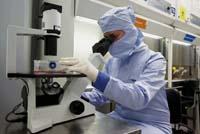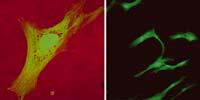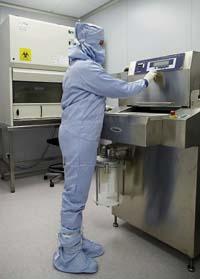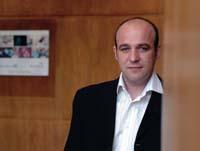Stem cells daily tool

The first embryonic stem cell bank was opened in Britain a few years ago. Currently in Spain there are three in Granada, Valencia and Barcelona. Without going any further, in November the first adult stem cell bank in Spain was inaugurated in San Sebastian: Inbiobank.
Today, banks are classified into stem cells of embryos and adult stem cells. However, in both cases the cells isolate, grow and store in one way or another. Subsequently, any national or international research laboratory has the possibility to obtain these samples. Cell banks store and distribute stem cells.
Stricter control measures
Until now, normally, laboratories went to hospitals in search of these tissues. The stem cells of these tissues were then isolated and growing in the laboratory itself. But that has some problems. In fact, many labs have conducted numerous stem cell research without any consent from the donor and without establishing means to know where the cells come from and where they go. The way to avoid and control all these problems are stem cell banks. In this sense, the director of Inbiobank, Cesar Trigueros, tells us that a new law will be implemented.

This law obliges, on the one hand, the approval of the donor, and even to inform the donor of the research in which these cells are to be used. It's not easy, don't think about it. Suppose a bank has several cells from a donor. These cells, after their growth in the laboratory, will be used in research. The new law requires a summary of the corresponding research before the laboratory initiates any research, which must be previously approved by the governing body.
Secondly, it will be essential to know at all times the cellular origin, that is, the data of the donor, the hospital from which it is sent, etc. And third, according to this law, the dynamism of banks is very important. That is, banks should not be just places to isolate, freeze and maintain cells; it is important to have a cell exchange with the rest of the banks. "This also forces us to network," says Cesar Trigueros.
In short, the implementation of the new law must take into account these three factors to meet the main objective of the stem cell bank. The main goal is to provide researchers with quality cells.
Through the bank
To obtain quality cells it is also essential to have quality facilities or facilities. However, as for the characteristics that banks should have, there is little written and each bank defines them. According to Trigueros, sterility is a basic element in a bench. "At Inbiobank we try to make the isolation, growth and freezing areas of cells as sterile as possible." All these facilities require a high degree of sterility to avoid any external contamination (bacteria, viruses, fungi...).

To achieve this, the facilities are completely airtight. There are several rooms where air renewal is constant. Thus, no particle, bacteria, etc. are included.
At the Inbiobank Bank in San Sebastian, three main areas can be distinguished with as many activities as quarantine, breeding and packaging. First, when you receive a sample from hospitals, you must pass a quarantine phase. That is, make sure this sample is not contaminated with any bacteria or viruses. Therefore, when the cells are isolated they remain quarantined and ensure that they do not have any pollution. If this sample is not contaminated, it goes to a later phase: the growth of these cells.
This room is even more sterilized. There a small sample is taken and the cells grow, usually up to millions of cells. In fact, the problem of adult stem cells is that they are very rare in tissues. In bone marrow, for example, only 0.1% of tissue is stem cells. The proportion is similar in other tissues.
How do cells grow? First they isolate the cells and place them in the petri dishes, always in conditions that favor their growth. In addition to these conditions, most cells need cow's serum to grow. This serum is mixed with salts, vitamins, etc. and apply it with cells, as it has a number of special features that help cell growth. Cells begin to fragment and grow. When the petri dish is filled, the cells are divided into two boxes and so on until millions and millions of cells grow.

They are then frozen and stored in small containers, in liquid nitrogen at -198 °C. They introduce them into a kind of warehouse where they are kept until they are distributed to laboratories.
Nothing in the air
The operator of the breeding and packaging areas is completely covered, carries a kind of pajamas and only the eyes are seen. It is a pajamas made with a special fabric that hardly generates dust. In addition, it is convenient for the worker to move as little as possible to minimize dust emission. Tables and chairs should also be made of special material, low dust generation. Tables, for example, must be made of stainless steel.
In addition to the amount of particles in the air, another aspect to consider is the pressure in the rooms. In the quarantine area, for example, there is negative pressure (lower than outside). This means that nothing can be taken out of that room. This room analyzes the presence of pathogens, bacteria or others. In this case, nothing will come out of this room.
All other rooms have positive pressure (higher than outside). Therefore, these rooms do not have access from the outside. In addition, in the journey between the exterior and the interior, this positive pressure is increasing: It is usually 30, 45 and 60 pascals approximately. Thus, in this route, the number of particles in the air is decreasing and in the interior room the risk of contamination of the samples is lower than in the exterior.

This is where samples are stored for years, among others, waiting for requests from laboratories, hospitals or pharmaceutical industries. However, these samples are also used for research carried out and to be carried out at the bank.
Stem cell research has aroused great hope and is currently also researching at Inbiobank. An artificial skin is currently being developed for the treatment of pusla epidermolisis. These patients have the absence of a protein that binds the dermis and epidermis. This artificial bark will be produced in the laboratory from the patient's cells and from a cell donor and will somehow act as an adhesive between the dermis and the epidermis.
Buletina
Bidali zure helbide elektronikoa eta jaso asteroko buletina zure sarrera-ontzian











